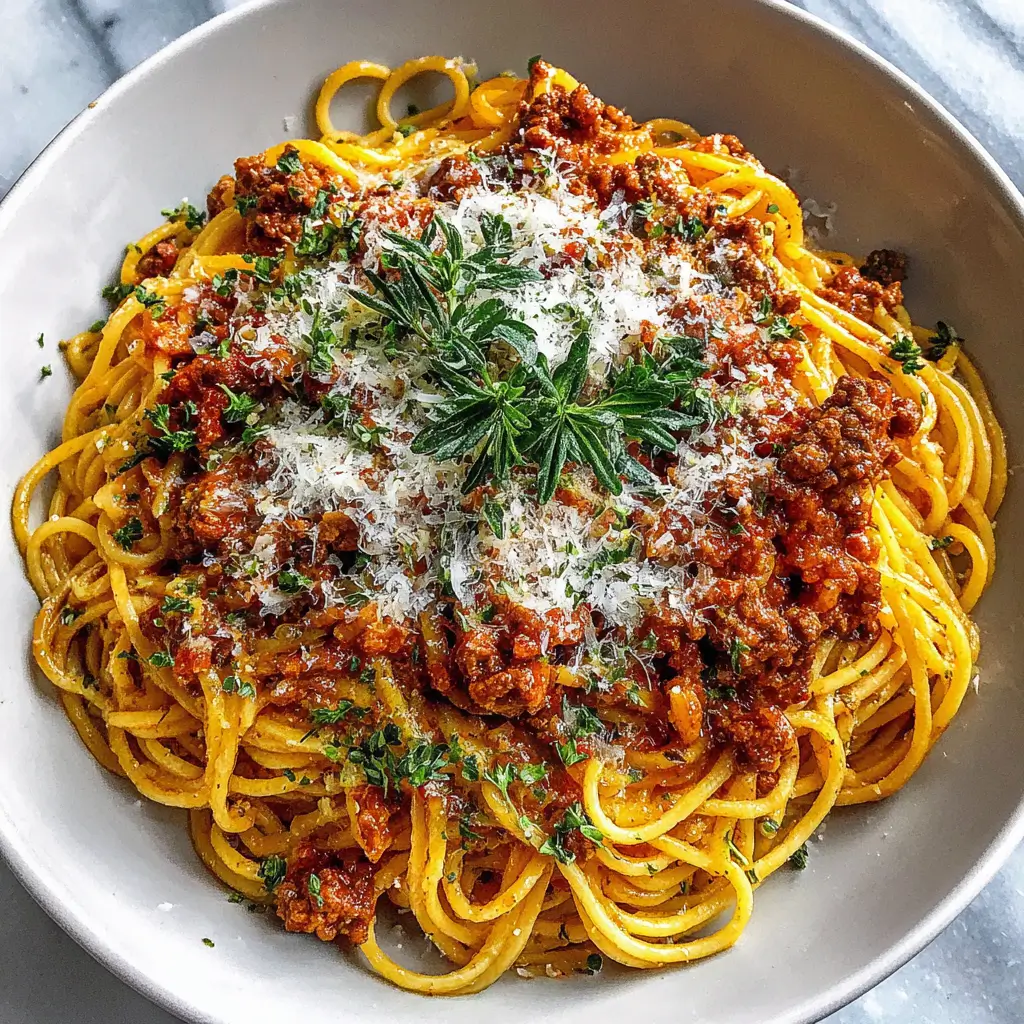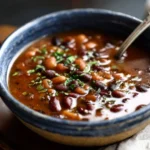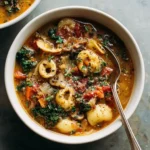Old-Fashioned Spaghetti with Meat Sauce: A Hearty Classic Reimagined
There’s something deeply comforting about a steaming plate of old-fashioned spaghetti with meat sauce. It evokes memories of family dinners, Sunday suppers, and the warm aroma of simmering tomatoes and herbs wafting through the house. This timeless dish, rooted in Italian-American culinary tradition, has become a staple in homes across North America and beyond. While its origins trace back to Italy, the version most recognize today—thick spaghetti smothered in a rich, meaty tomato sauce—was shaped in American kitchens during the early 20th century by Italian immigrants adapting their homeland recipes with local ingredients.
The History of Old-Fashioned Spaghetti with Meat Sauce
The story of spaghetti with meat sauce begins not in Italy, where pasta is often served with simpler, oil- or cheese-based sauces, but in the United States. During the late 1800s and early 1900s, waves of Italian immigrants brought their culinary traditions to cities like New York, Chicago, and Boston. However, due to the greater availability and affordability of meat in America compared to war-torn or economically strained southern Italy, cooks began enriching traditional tomato sauces with ground beef, pork, or a combination of meats.
This adaptation gave birth to what we now call “meat sauce” or “Sunday gravy”—a slow-simmered sauce passed down through generations. The term “gravy” in Italian-American households doesn’t refer to the poultry condiment, but rather to any rich, cooked tomato sauce, especially one made with meat. These meals were often prepared on Sundays after church, allowing hours of slow cooking that deepened the flavors and brought families together around the table.
Over time, this dish evolved into a cultural icon, featured in diners, cookbooks, and home kitchens alike. Its popularity soared mid-century with the rise of canned tomatoes, pre-ground meat, and packaged spaghetti, making it accessible even to novice cooks. Today, while gourmet versions exist, the old-fashioned style remains beloved for its simplicity, heartiness, and nostalgic warmth.
Ingredients Breakdown: What Makes the Sauce Sing?
The magic of old-fashioned spaghetti with meat sauce lies in its humble yet harmonious blend of ingredients. Each component plays a vital role in building layers of flavor, texture, and depth. Here’s a detailed look at what goes into an authentic rendition:
- Ground Meat: Traditionally, a mix of ground beef and pork is used for richness and juiciness. Some variations include veal or even sausage for extra flavor. The fat content helps carry flavor and prevents dryness.
- Onion and Garlic: These aromatics form the flavor base. Yellow onions provide sweetness when sautéed, while fresh garlic adds pungency and complexity.
- Extra Virgin Olive Oil: Used for sautéing, it imparts a fruity, peppery note that enhances the overall taste profile.
- Canned Crushed Tomatoes: High-quality San Marzano-style tomatoes are ideal—they’re naturally sweet with low acidity. Whole tomatoes crushed by hand can also be used for a chunkier texture.
- Tomato Paste: Concentrated and deeply savory, tomato paste adds body and umami, helping to thicken the sauce and deepen its color.
- Beef Broth or Water: Adds moisture and helps regulate consistency. Beef broth enriches the meaty flavor.
- Dried Herbs: Oregano, basil, and sometimes thyme or marjoram are essential. Dried herbs are preferred in long-simmered sauces as they release flavor slowly.
- Fresh Herbs (optional): Parsley or basil added at the end brightens the dish.
- Sugar (optional): A pinch balances the natural acidity of tomatoes, especially if using non-San Marzano varieties.
- Red Wine (optional but recommended): Dry red wine such as Chianti or Cabernet adds complexity and acidity that meld beautifully with the meat and tomatoes.
- Salt and Black Pepper: Crucial for seasoning at every stage to layer flavor properly.
- Olive Oil or Butter for Finishing: A drizzle of olive oil or a knob of butter stirred in at the end gives the sauce a silky, restaurant-quality finish.
- Parmesan Cheese Rind (secret ingredient): Simmered in the sauce, it adds subtle saltiness and umami without overpowering.
Step-by-Step Recipe: How to Make Old-Fashioned Spaghetti with Meat Sauce
Follow this detailed guide to recreate the classic comfort dish exactly as Grandma might have done—with love, patience, and attention to detail.
- Prepare Ingredients: Chop one medium yellow onion finely. Mince 3–4 cloves of garlic. Measure out 1 lb ground beef, ½ lb ground pork (or all beef if preferred), 28 oz crushed tomatoes, 2 tbsp tomato paste, 1 cup beef broth, ½ cup red wine (optional), 1 tsp dried oregano, 1 tsp dried basil, 1 bay leaf, salt, pepper, and optional Parmesan rind.
- Sauté Aromatics: In a large heavy-bottomed pot or Dutch oven, heat 2 tablespoons of olive oil over medium heat. Add chopped onions and cook until translucent and lightly golden (about 5–7 minutes). Stir in minced garlic and cook for another 30 seconds until fragrant—do not let it burn.
- Brown the Meat: Increase heat to medium-high. Add the ground meats, breaking them apart with a wooden spoon. Cook until well-browned, about 8–10 minutes. Drain excess fat if desired, though leaving some enhances flavor.
- Add Tomato Paste: Push the meat mixture to one side of the pot. Add 2 tablespoons of tomato paste to the cleared space and cook for 1–2 minutes, stirring constantly. This step, called “blooming,” intensifies the paste’s flavor and removes raw notes.
- Incorporate Liquids: Stir the tomato paste into the meat mixture. Pour in ½ cup red wine (if using) and simmer until mostly evaporated, about 3 minutes. This deglazes the pan and lifts flavorful browned bits (fond).
- Add Tomatoes and Seasonings: Stir in crushed tomatoes, beef broth, dried oregano, dried basil, bay leaf, optional Parmesan rind, salt, and pepper. Mix thoroughly. For balance, add a pinch of sugar (about ½ tsp) if the tomatoes are acidic.
- Simmer Slowly: Reduce heat to low. Cover partially and let the sauce simmer gently for at least 1.5 to 2 hours, stirring occasionally. The longer it simmers (up to 4 hours), the richer and more developed the flavor becomes. Add splashes of water or broth if the sauce thickens too much.
- Cook the Spaghetti: About 15 minutes before serving, bring a large pot of salted water to a boil (use about 1 tablespoon salt per 4 quarts water). Add 1 lb dried spaghetti and cook according to package directions until al dente—usually 8–10 minutes. Reserve 1 cup of starchy pasta water before draining.
- Finish the Sauce: Remove bay leaf and Parmesan rind. Taste and adjust seasoning with salt, pepper, or a splash of red wine vinegar for brightness. Stir in a tablespoon of butter or a drizzle of olive oil for silkiness.
- Combine or Serve Separately: Toss the drained spaghetti with a portion of the sauce and a splash of reserved pasta water to help the sauce cling. Alternatively, serve sauce over spaghetti plated individually.
- Garnish and Serve: Top with freshly grated Parmesan cheese, chopped fresh parsley, and a grind of black pepper. Serve immediately with garlic bread and a green salad.
Tips for the Perfect Old-Fashioned Spaghetti with Meat Sauce
- Brown, Don’t Gray: Take time to properly brown the meat—it develops fond (the caramelized bits on the pot bottom), which adds immense flavor when deglazed.
- Low and Slow Wins: Never rush the simmer. Extended cooking allows collagen in the meat to break down, fats to emulsify, and flavors to meld.
- Salt in Stages: Season lightly at each step—after browning meat, after adding tomatoes, and again at the end. This builds balanced flavor.
- Use Quality Tomatoes: Opt for brands like Bianco DiNapoli, Cento, or San Marzano DOP-certified tomatoes for superior taste.
- Reserve Pasta Water: The starchy liquid helps bind the sauce to the noodles, creating a cohesive dish.
- Undercook Pasta Slightly: Since it will absorb sauce, pull spaghetti from water 1 minute before suggested time to avoid mushiness.
- Let Sauce Rest: Like chili or stew, the sauce tastes better the next day. Make it ahead when possible.
- Stir Gently: Use a wooden spoon or silicone spatula to avoid breaking down the sauce too much.
Variations and Customizations
While the traditional recipe holds a special place in hearts, countless variations keep this dish exciting and adaptable to modern tastes and dietary needs:
- Meat Variations: Try Italian sausage (sweet or hot), ground turkey, chicken, or lamb. A combo of beef and sausage is especially popular.
- Vegan/Vegetarian Version: Replace meat with lentils, mushrooms, textured vegetable protein (TVP), or plant-based crumbles. Use vegetable broth and omit cheese for a fully vegan dish.
- Spicy Kick: Add red pepper flakes during sautéing or stir in a diced jalapeño for heat.
- Extra Veggies: Sauté carrots, celery, bell peppers, or zucchini with the onions for added nutrition and sweetness.
- Wine-Free Option: Substitute red wine with additional beef broth and a splash of balsamic vinegar for acidity.
- Creamy Twist: Stir in a splash of heavy cream or mascarpone at the end for a richer, pink-hued sauce.
- Different Pastas: Use linguine, fettuccine, penne, or rigatoni for varied textures. Whole wheat or gluten-free pastas work well too.
- Freezer-Friendly: Double the batch and freeze portions for up to 3 months. Thaw overnight and reheat gently on the stove.
Health Considerations and Nutritional Value
Old-fashioned spaghetti with meat sauce can be part of a balanced diet when enjoyed in moderation and with mindful tweaks. Here’s a nutritional overview (per serving, approx. 1 cup sauce + 2 oz dry spaghetti):
- Calories: ~400–500 kcal
- Protein: 18–22g (from meat and pasta)
- Fat: 15–20g (mostly from meat and olive oil; choose leaner meats to reduce)
- Carbohydrates: 50–60g (mainly from pasta)
- Fiber: 5–7g (especially if whole grain pasta and vegetables are added)
- Sodium: 600–900mg (can be reduced by using low-sodium broth and tomatoes)
- Vitamins & Minerals: Rich in lycopene (from tomatoes), vitamin C, iron, and B vitamins.
Healthy Modifications:
- Use lean ground turkey or chicken instead of beef.
- Increase vegetable content by adding spinach, mushrooms, or pureed carrots.
- Opt for whole grain or legume-based pasta for higher fiber and protein.
- Reduce oil and drain excess fat from meat to lower saturated fat.
- Control portion sizes—aim for 1 to 1.5 cups sauce per person with a side salad.
Ingredients
- 2 tbsp extra virgin olive oil
- 1 medium yellow onion, finely chopped
- 3–4 garlic cloves, minced
- 1 lb ground beef (80/20)
- ½ lb ground pork (optional; substitute with more beef if needed)
- 2 tbsp tomato paste
- ½ cup dry red wine (e.g., Chianti or Cabernet Sauvignon; optional)
- 1 (28 oz) can crushed tomatoes (preferably San Marzano)
- 1 cup beef broth (or water)
- 1 tsp dried oregano
- 1 tsp dried basil
- 1 bay leaf
- 1 small Parmesan cheese rind (optional but recommended)
- ½ tsp sugar (optional)
- Salt and freshly ground black pepper to taste
- 1 lb dried spaghetti
- 1 tbsp unsalted butter or olive oil (for finishing)
- Freshly grated Parmesan cheese, for serving
- Fresh parsley, chopped, for garnish
Directions
- Heat olive oil in a large Dutch oven over medium heat. Add onions and cook until soft and golden, about 6–7 minutes. Add garlic and cook for 30 seconds until fragrant.
- Add ground beef and pork. Cook, breaking up with a spoon, until browned and no longer pink, about 8–10 minutes. Drain excess fat if desired.
- Push meat to one side. Add tomato paste to the cleared area and cook for 1–2 minutes, stirring frequently, until darkened and fragrant.
- Stir tomato paste into meat. Pour in red wine and simmer until reduced by half, about 3 minutes.
- Add crushed tomatoes, beef broth, oregano, basil, bay leaf, Parmesan rind, sugar (if using), salt, and pepper. Stir well.
- Bring to a gentle simmer. Reduce heat to low. Partially cover and cook for 1.5 to 2 hours, stirring occasionally. Add water or broth if too thick.
- About 15 minutes before serving, bring a large pot of salted water to a boil. Cook spaghetti until al dente. Reserve 1 cup pasta water, then drain.
- Remove bay leaf and Parmesan rind from sauce. Stir in butter or olive oil. Adjust seasoning.
- Toss spaghetti with sauce and a splash of reserved pasta water. Serve hot with Parmesan and parsley.
FAQ
Can I make this ahead of time?
Yes! This sauce tastes even better the next day. Store in an airtight container in the fridge for up to 4 days or freeze for up to 3 months.
Can I use fresh tomatoes instead of canned?
Absolutely. Blanch and peel about 2.5 lbs ripe tomatoes, then crush them. Simmer longer to reduce excess moisture.
Why is my sauce too acidic?
Some tomatoes are naturally more acidic. Add a pinch of sugar, a small piece of carrot while simmering, or a teaspoon of butter to mellow the flavor.
Can I cook the sauce in a slow cooker?
Yes. After browning meat and sautéing aromatics, transfer everything to a slow cooker and cook on low for 6–8 hours or high for 3–4 hours.
What’s the best cheese to serve with it?
Freshly grated Parmigiano-Reggiano is ideal. Pecorino Romano offers a sharper, saltier alternative.
Is this recipe kid-friendly?
Definitely. Many children love the mild, savory flavor. You can puree part of the sauce or add extra veggies to sneak in nutrients.
Can I use ground sausage instead of beef?
Yes. Italian sausage (mild or hot) adds robust flavor. Remove casing and brown just like ground meat.
Summary
Old-fashioned spaghetti with meat sauce is a soul-warming classic that combines tender pasta with a rich, slow-simmered sauce of ground meat, tomatoes, and aromatic herbs. Heirloom flavors, simple ingredients, and the magic of time come together in this beloved Italian-American favorite.










